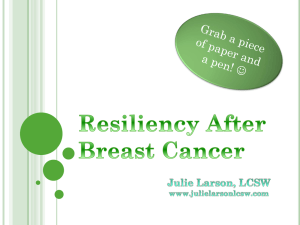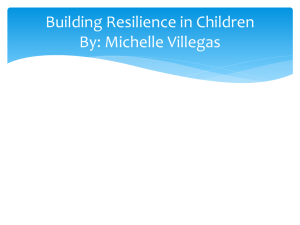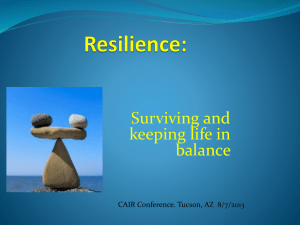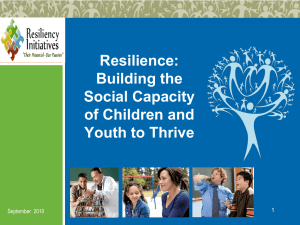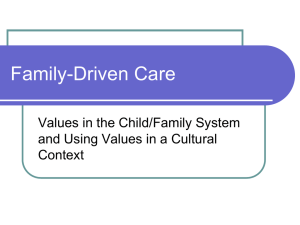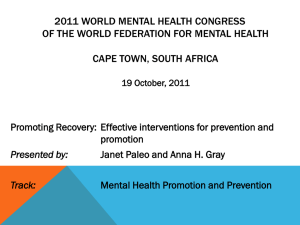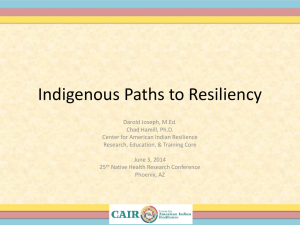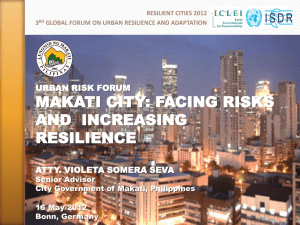Resilience and Resiliency Training
advertisement
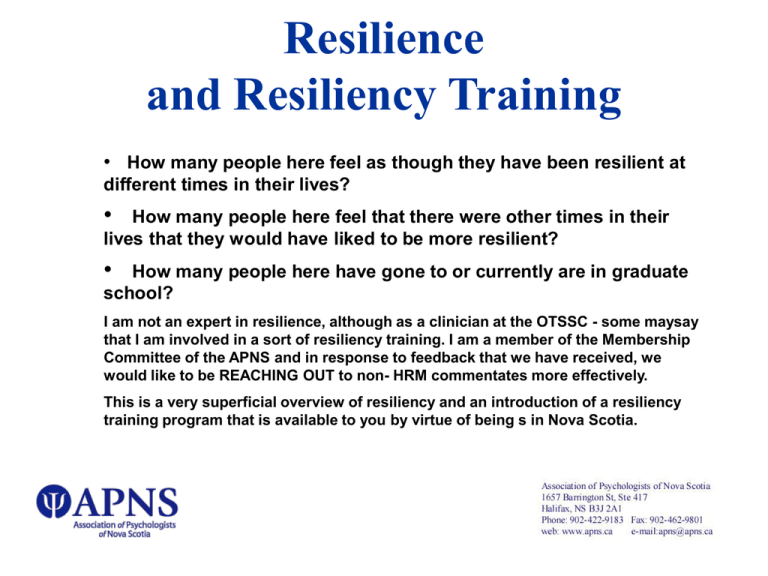
Resilience and Resiliency Training • How many people here feel as though they have been resilient at different times in their lives? • How many people here feel that there were other times in their lives that they would have liked to be more resilient? • How many people here have gone to or currently are in graduate school? I am not an expert in resilience, although as a clinician at the OTSSC - some maysay that I am involved in a sort of resiliency training. I am a member of the Membership Committee of the APNS and in response to feedback that we have received, we would like to be REACHING OUT to non- HRM commentates more effectively. This is a very superficial overview of resiliency and an introduction of a resiliency training program that is available to you by virtue of being s in Nova Scotia. Resilience and Resiliency Training Outline 1. Definition and Basic Theories 2. Initial research 3. Resiliency Training - Outcome Research 4. What APNS can do 5. A Resiliency Training Program Given that we are Psychologists Review the literature to explore what the research has told us about Resiliency This is not an exhaustive list, nor is it a critical review Resilience and Resiliency Training Resilience • “resourceful adaptation to changing circumstances and environmental contingencies” -- Block & Block, 1980 • “the capacity for recovery and maintained adaptive behaviour that may follow initial retreat or incapacity upon initiating a stressful event” --- Garmezy, 1991 • “the positive pole of individual differences in people’s response to distress and adversity -- Rutter, 1987 • “A motivation (drive) and/or set of skills which direct people to cope or adapt in ways that maximize emotional, physical and psychological well-being -- especially in the face of adversity -- Hill, 2004 - open to discussion Resilience and Resiliency Training Theory # 1 • Reaction to problem / diagnostic focus of clinical psychology -- Werner, 1982 • The possession of developmental assets and protective factors -- Richardson, 2002 • Rather than focus on the 20-30% of the “at risk” children, why not focus on qualities, assets and protective factors of the 70-80% who do not manifest pathology or dysfunction -Barnard, 1987 This theory focused more on the paradigm shift from being problem focused of the minority to exploring the strengths of the majority Resilience and Resiliency Training Theory #2 Resilience = process • Life stressors happen. Reactions to life stressors can either improve functioning (resilience), maintain functioning (coping) or reduce functioning (dysfunction) -- Richardson, 1990 This theory focused more on the fact that resilience appeared not only to be the presence of strengths but the presence of strength in the face of adversity Making silk from a sow’s ear Making the most of a bad situation Resilience and Resiliency Training Theory #3 • • Resilience describes an increased energy to grow -- Wilber, 1996 Could be biological or spiritual (e.g., a genetically “stronger:’ parasympathetic system response) or a firmly entrenched belief or value system -- Hill, 2004 Resilient reintegration requires increased energy to grow (according to Richardson , 2002) Wilber describes “the great chain of being” a stemming from the: Core of matter (Physics) with successive circular and interdependent layers described as: • Life (Biology) • Mind (Psychology) • Soul )Theology) • Spirit (Mysticism) However, both Wilber and Richardson neglect to consider genetic and/or environmental contribution to “increased energy to grow.” Resilience and Resiliency Training Research • Marked increase in “resilience and resiliency” research in the past decade -- Barnard, 1997 • Michael Rutter 1979, 1985 -- despite “many risk factors” 25% of youths were resilient. These children were more likely to be female, have demonstrated and “easy temperament”, experienced a “positive school climate”, demonstrated self-mastery, self-efficacy and planning skills and to have experienced a “positive and supportive relationship with an adult.” Resilience and Resiliency Training Research (continued) • Emmy Werner, 1982 -- almost 50% of “at risk” youth demonstrated adaptive function. These youth were more likely to be female, socially responsible, adaptable, tolerant, achievement oriented, good communication skills, and have high esteem. Resilience and Resiliency Training Summary of Findings • Wolkow & Ferguson, 2001 -- Within child • High self esteem, “warmth” and positive social orientation -- External to child • • Families -- warm, cohesive, good boundaries Communities -- additional supports and role models prominent and available in the community at large. Resilience and Resiliency Training Resiliency Training • Maddi, 1997, 1998 & 2002 -- Developing coping strategies for stressful circumstances -- Social skills training -- Self care (including parasympathetic response training, I.e., relaxation training, autogenic training, mediation) Resilience and Resiliency Training Outcome Research • Maddi, 1997, 1998 & 2002 -- Illinois Bell Telephone (IBT) Co. and undergrads -- in the first group, training associated with increased job satisfaction, decreased levels of stress, less distrust, lower anxiety and lower blood pressure than IBT managers who did not receive the training -- The second group were graduate students who either went through resiliency training or “conventional student enrichment” training. The experimental group both coping effectiveness and GPA increased in the following year Resilience and Resiliency Training Preventive Studies • Hughes, 2003 -- Greater risks when directed to lower income “at risk” individuals -- Low SES urban youth reported less risk-taking (theft and violence scales), improved school attitudes, increased internal locus of control, increased knowledge about anger and self control and increased goal setting compared to controls -- Higher SES suburban youth demonstrated fewer differences from controls. There were slight increases in learning (not knowledge) of anger and self control issues and slightly higher ratings in cooperation and consideration problem-solving ratings Resilience and Resiliency Training Preventive Studies (continued) • Marrett, Sonderegger & Xenos, 2003 -- Compared young, culturally diverse, non-English speaking migrants to Australia with and without resiliency training -- Treatment group demonstrated higher self esteem, reduced “internalizing problems” (CBCL) and more optimism about the future than wait-list controls. Resilience and Resiliency Training What APNS Can Do •Increased requests of Psychology as a profession to assist in “bolstering the psychological immune system” -- Carpenter, 2001 Examples: • CF -- OTSSC •American Psychological Association -Carpenter, 2001 & Daw, 2002 •Romanow Report APA Membership PEC Resiliency Training
